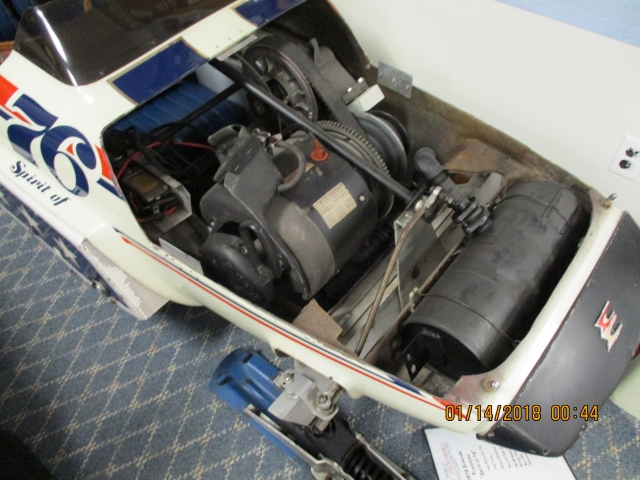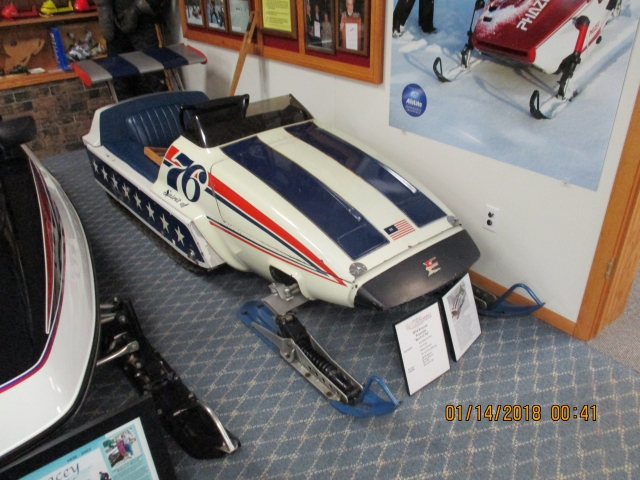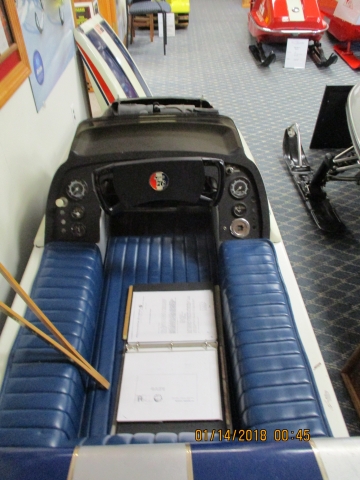Subbmitted by: Olav Aaen
Back in the early seventies as the industry was dialing in on what would be a practical snowmobile, there were a lot of experimenting with both single ski and twin track sleds. There were both Twin track Manta Trail and Race sleds, and of course Gilles Villeneuves Twin Track Alouette racer. Gilles Twin Tracker showed all the signs of a winning concept once he got off the line. He was often slower in the start, but once he got going he could pass at will in the corners. The Alouette had the engine in the back between the track, and the driver in front race car style, and the Manta’s was of the same design. We felt that the weight distribution would maybe be more favorable with the engine up front and the driver between the tracks. Since the engine only weighted about 80 lbs, and the average driver 160 lbs, there would be more weight on the track, and therefore better hook up on the start. How would you place the driver? Should he sit leaned back or on his knees as was the practice in race boats. We felt that kneeling in between the tracks might give the racer a chance to stand up at the start for better weight distribution, and he would also be able to lean out over the inside track in the turns. So we made some layout sketches and showed them to the management. They were not well received, but not because it was not a good idea.
It turned out that the vehicle department was thinking in the same direction. Evinrude had a designer/stylist on contract. His name was Brook Stevens, already famous for his industrial designs and his manufacturing of the Excalibur car, a very nice retro-styled vintage car looking like the famous Duesenberg long hood movie star cars of the roaring twenties, but on a modern Chevy chassis. Stevens had just started on the twin track front engine concept sled for the Snow Show season. It had the driver leaning back and holding a steering wheel. The cockpit was padded, it had an Indy style wing in the back, a rotary Wankel engine in the front and futuristic Cobra skis from Mechanical Industries in front. The styling was great and the whole machine was very low to the ground. Because his project was ongoing we were told to back off for the time being on the race sled. Marketing wanted to show the sled on the fall Show Circuit to gauge the public interest. If there was great interest, and a twin tracker went into production, it would be of interest to have a twin track race sled program, but if we only made conventional single trackers, we should race single trackers, was marketing’s opinion, and they were correct as history proved later. The Stevens Show Machine created interest, enough to encourage further investigation of the concept. Although the sled was sleek and futuristic there was a major problem with the lay back driver position. It was good on glare ice, but once you hit rough trail you were thrown around and ended up with a sore back due to the limited suspension available at the time. To try and solve this problem, a twin track prototype was made were the driver had his feet in the well between the tracks, but he sat on a sort of banana shaped bicycle style seat. This meant that the driver could stand up in the bumpy sections and use his legs as shock absorbers, just like on a single tracker. The twin track prototype also steered real well in the corners, which was actually a surprise. In the end the concept was more expensive to build, not as easy to carry a passenger on and of course heavier and more difficult to transport on just an open double trailer. When the whole thing was evaluated, it was questionable if enough units could be sold to be a profitable venture. The twin track concept had performance advantaged as Ski-Doo would later prove with their very successful Oval racing F1 sleds. Ski-Doo also found a better position for the driver, sitting on top of the inside track tunnel. The Ski-Doo twin tracker was actually so dominant that the other manufacturers pulled out of the F-1 pro circuit, because they saw no value in allocating engineering resources to racing sleds that did not directly contribute to their bread and butter. Ski-Doo actually made a side-by-side twin track sled called the Elite, but it found limited acceptance. The other manufacturers instead concentrated on F-3 production based Oval-Racing sleds and the new emerging sport of Sno-Cross racing. To keep oval racing alive circuits went back to “Champ” class single track sleds which is now the top class at the Eagle River World Championship. So it turned out that the Evinrude marketing department was correct in their evaluation. The Stevens prototype was a great looking and futuristic styling exercise. The sled today sits prominently in the International Snowmobile Hall of Fame Museum next to the Derby Race Track in Eagle River, a great showpiece documenting a historical golden Era of snowmobile development.


.JPG)





